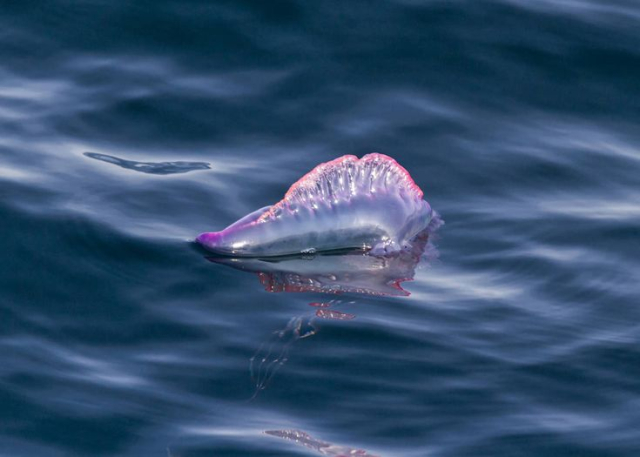The marine organism called the Portuguese Frigatebird or also known as the Portuguese man-of-war, belongs to the group of hydrozoans, to the species Physalia physalis and is a colony of specialized organisms that work together to survive. Furthermore, its appearance is distinctive: it has a floating bladder, which resembles a sail , which can reach considerable sizes, where below this bladder, long tentacles hang , which can measure several meters and contain stinging cells that release a poison. powerful , used for hunting and defense. These organisms usually float on the ocean surface , propelled by wind and currents, although they can also sink temporarily . Sometimes they group together in large numbers, especially during certain times of the year or in specific areas of the ocean.
Where is the Portuguese Frigate located?
It is commonly found in warm and temperate waters of the Atlantic, Indian and Pacific oceans, preferably in areas where ocean currents are strong and can carry it to places where it can find food. The geographical distribution of the Portuguese frigatebird can vary depending on ocean currents and climatic conditions. For example, during certain seasons, they may be carried by currents to areas where they are not normally found and appear in groups floating on the surface of the water.
Is the Portuguese Frigate dangerous?
The Portuguese frigate can definitely represent a danger to humans; Since their bites are very painful and, in most cases, dangerous if nothing is done about it. Although the bite itself is rarely fatal to humans, it can cause a number of symptoms and adverse reactions.
When the tentacles of this organism come into contact with the skin, the stinging cells (from the tentacles) adhere and release the venom that causes intense pain, redness, inflammation, itching and rashes. In fact, in several cases stings can trigger severe allergic reactions, including breathing difficulties, irregular heart palpitations, and, in extreme cases, anaphylactic shock. Clearly, it must be kept in mind that the sting reaction can vary depending on individual sensitivity, the amount of venom injected and the area of the body affected, and those symptoms can persist for several hours or even days afterwards.
What to do if the Portuguese frigatebird bites me?
-
When faced with a Portuguese frigatebird bite, it is recommended to rinse the affected area with sea or salt water , but not fresh water, as this can further stimulate the release of venom. Salt water can help wash remnants of tentacles and venom from the skin. In fact, many people choose to apply urine to the bite , as they have traditionally done.
-
Rubbing the skin should be avoided , as this can worsen symptoms by releasing more venom.
-
Moderate heat in the form of warm compresses or hot cloths can be applied to the affected area to help relieve pain. Be careful not to burn the skin with excessive heat.
-
Some experts recommend applying vinegar to the bite to deactivate any stinging cells that may still be active. However, this may not be effective for all Portuguese frigatebird species and may not be recommended in all situations.
-
Over-the-counter pain relievers, such as ibuprofen or acetaminophen, can be taken to help relieve the pain and discomfort associated with the bite.
-
In cases of severe bites, where symptoms such as difficulty breathing, dizziness, nausea or vomiting occur, it is essential to seek medical attention immediately. In some cases, treatment with stronger antihistamines, corticosteroids, or pain medications may be necessary.
What is the life cycle of the Portuguese Frigate?
The life cycle of this species includes several stages, both sexual and asexual:
- There are separate male and female individuals. For sexual reproduction, males release sperm into the water, which is carried by ocean currents. This sperm is captured by the females that are releasing eggs.
- When the eggs are fertilized, they develop into larvae, which are early juvenile forms of this species and can be carried by ocean currents for weeks or months before fully maturing.
- Eventually, these larvae settle and develop into colonies where they become adults. Each of those colonies consists of several types of specialized individuals, including floaters, tentacles, and polyps, working together to allow the survival and reproduction of the colony.
Regarding asexual reproduction, they reproduce by a process called budding. During this process, the mother colony produces clones of itself, which eventually separate and become independent colonies. Once colonies reach sexual maturity, they can reproduce both sexually and asexually, perpetuating the life cycle of the species.
Differences between the Portuguese Frigatebird and the jellyfish
Taxonomy and structure:
-
The Portuguese frigatebird, Physalia physalis, is not actually a jellyfish, but rather a colonial hydrozoan. It is made up of a colony of specialized organisms that work together to survive. The Portuguese frigatebird includes floats, tentacles and polyps.
-
Jellyfish, on the other hand, are solitary organisms belonging to the phylum Cnidaria and the class Scyphozoa. They have a bell-shaped body and tentacles hanging from the bottom.
In case of the physical structure:
-
The Portuguese frigatebird has a floating bladder, which resembles a sail, and long tentacles hang from it that can reach several meters in length.
-
Jellyfish have a bell-shaped gelatinous body, with tentacles hanging below it. Its structure is simpler compared to the complexity of the Portuguese frigate.
Feeding system:
-
Both the Portuguese frigatebird and the jellyfish are carnivorous and feed on small fish, plankton and other marine organisms.
-
The Portuguese frigatebird catches its prey with its poisonous tentacles and ingests them through its mouth.
-
Jellyfish also use their tentacles to capture prey, but their feeding process can vary depending on the species.
Defense mechanisms and poison:
-
Both have stinging cells on their tentacles that release venom to hunt prey and defend themselves against predators.
-
The venom of the Portuguese frigatebird is extremely potent and can cause severe allergic reactions in humans, while jellyfish may have less potent venoms.
If you see a Portuguese frigatebird while you are in the water or near shore, it is important to keep your distance and avoid all contact with this poisonous organism, especially its tentacles. Never try to touch or handle a Portuguese frigatebird, as its stings can be painful and even dangerous. If you see a Portuguese Frigatebird in the water, warn others and notify local authorities responsible for beach safety or the marine environment. If you are unfortunately stung, get out of the water immediately and seek medical attention if you experience severe symptoms.
We invite you to take a look at other articles at: https://yate.co/es/blog


